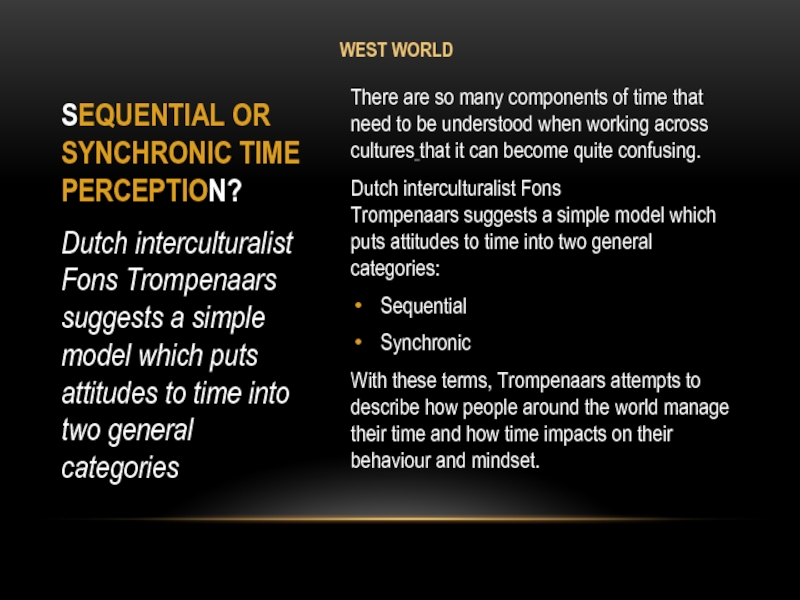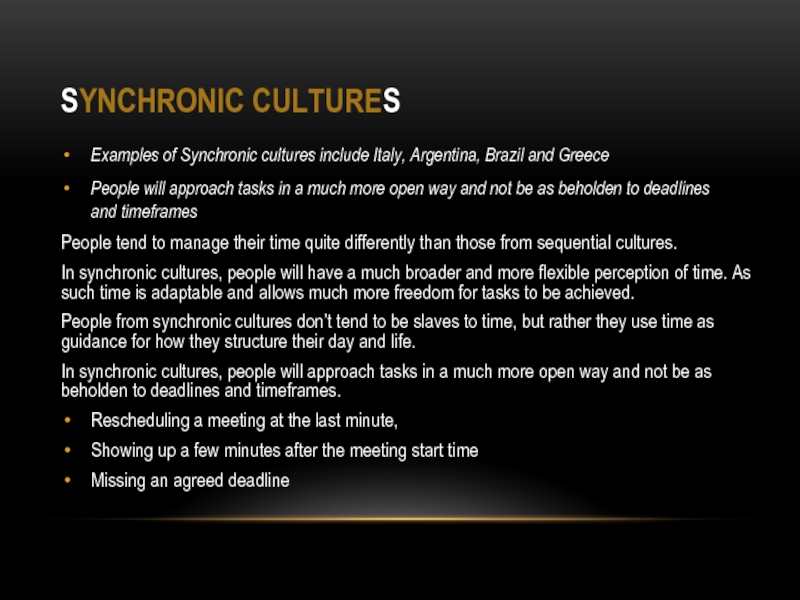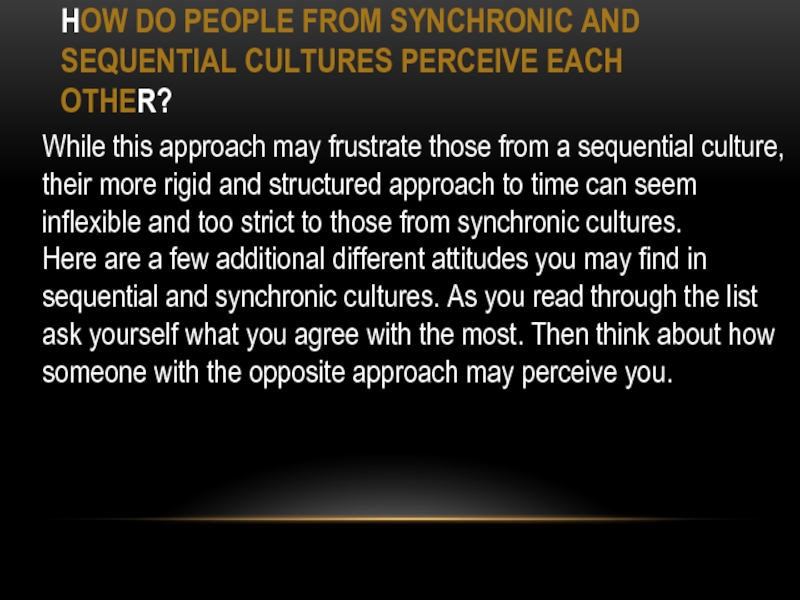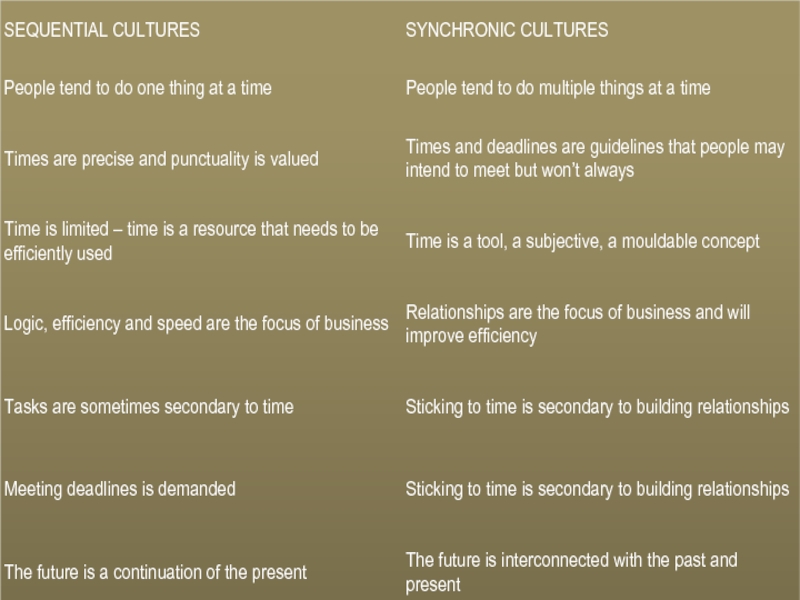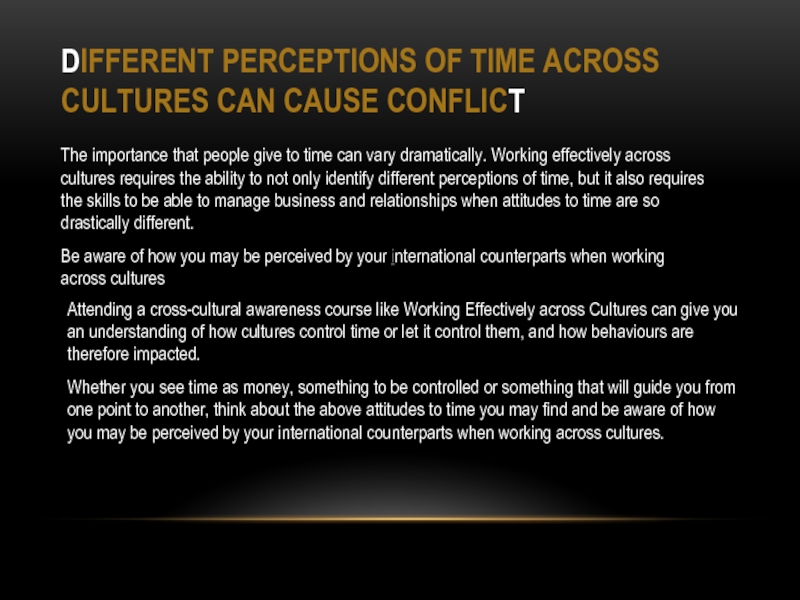- Главная
- Разное
- Дизайн
- Бизнес и предпринимательство
- Аналитика
- Образование
- Развлечения
- Красота и здоровье
- Финансы
- Государство
- Путешествия
- Спорт
- Недвижимость
- Армия
- Графика
- Культурология
- Еда и кулинария
- Лингвистика
- Английский язык
- Астрономия
- Алгебра
- Биология
- География
- Детские презентации
- Информатика
- История
- Литература
- Маркетинг
- Математика
- Медицина
- Менеджмент
- Музыка
- МХК
- Немецкий язык
- ОБЖ
- Обществознание
- Окружающий мир
- Педагогика
- Русский язык
- Технология
- Физика
- Философия
- Химия
- Шаблоны, картинки для презентаций
- Экология
- Экономика
- Юриспруденция
Time in different cultures презентация
Содержание
- 1. Time in different cultures
- 2. ATTITUDE TO TIME Attitudes to time may differ
- 3. SEQUENTIAL OR SYNCHRONIC TIME PERCEPTION? Dutch interculturalist
- 4. Examples of Sequential cultures includes the UK,
- 5. Examples of Synchronic cultures include Italy, Argentina, Brazil
- 6. HOW DO PEOPLE FROM SYNCHRONIC AND SEQUENTIAL
- 8. The importance that people give to time
Слайд 2ATTITUDE TO TIME
Attitudes to time may differ between different cultures in often quite significant
Attitudes to time in Mediterranean and Middle Eastern countries is very different from that in time-conscious cultures like North America and Northern Europe
Слайд 3SEQUENTIAL OR SYNCHRONIC TIME PERCEPTION?
Dutch interculturalist Fons Trompenaars suggests a simple
There are so many components of time that need to be understood when working across cultures that it can become quite confusing.
Dutch interculturalist Fons Trompenaars suggests a simple model which puts attitudes to time into two general categories:
Sequential
Synchronic
With these terms, Trompenaars attempts to describe how people around the world manage their time and how time impacts on their behaviour and mindset.
WEST WORLD
Слайд 4Examples of Sequential cultures includes the UK, Germany, South Africa, USA,
Time tends to control and influence what people do in sequential cultures
Trompenaars argues that time is dealt with in a specific logical order.
For example, people from a sequential culture may prefer to have a detailed agenda for meetings and regular milestones throughout the life cycle of a project. They rely on this structure and can find a more flexible approach to time frustrating.
Time tends to control and influence what people do in sequential cultures, and many will find value in the expression ‘time is money’.
SEQUENTIAL CULTURES
Слайд 5Examples of Synchronic cultures include Italy, Argentina, Brazil and Greece
People will approach
People tend to manage their time quite differently than those from sequential cultures.
In synchronic cultures, people will have a much broader and more flexible perception of time. As such time is adaptable and allows much more freedom for tasks to be achieved.
People from synchronic cultures don’t tend to be slaves to time, but rather they use time as guidance for how they structure their day and life.
In synchronic cultures, people will approach tasks in a much more open way and not be as beholden to deadlines and timeframes.
Rescheduling a meeting at the last minute,
Showing up a few minutes after the meeting start time
Missing an agreed deadline
SYNCHRONIC CULTURES
Слайд 6HOW DO PEOPLE FROM SYNCHRONIC AND SEQUENTIAL CULTURES PERCEIVE EACH OTHER?
While
Here are a few additional different attitudes you may find in sequential and synchronic cultures. As you read through the list ask yourself what you agree with the most. Then think about how someone with the opposite approach may perceive you.
Слайд 8The importance that people give to time can vary dramatically. Working
Be aware of how you may be perceived by your international counterparts when working across cultures
Attending a cross-cultural awareness course like Working Effectively across Cultures can give you an understanding of how cultures control time or let it control them, and how behaviours are therefore impacted.
Whether you see time as money, something to be controlled or something that will guide you from one point to another, think about the above attitudes to time you may find and be aware of how you may be perceived by your international counterparts when working across cultures.
DIFFERENT PERCEPTIONS OF TIME ACROSS CULTURES CAN CAUSE CONFLICT


